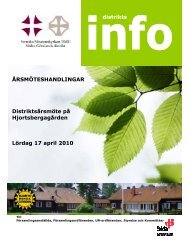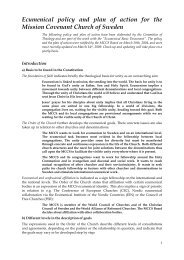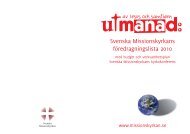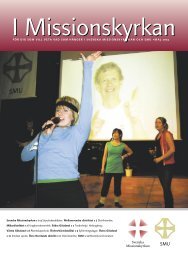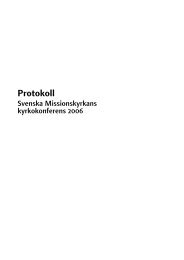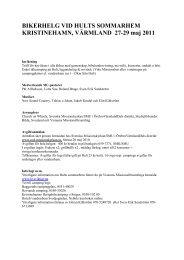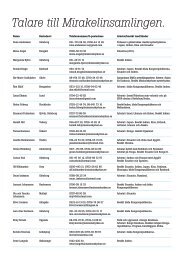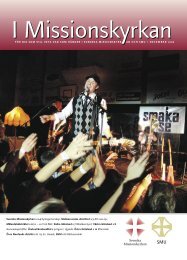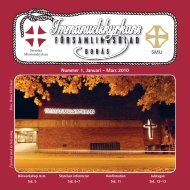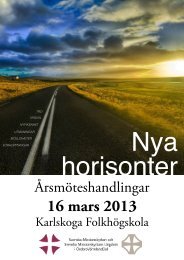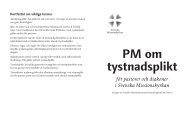Mission and Revolution in Central Asia - Svenska Missionskyrkan
Mission and Revolution in Central Asia - Svenska Missionskyrkan
Mission and Revolution in Central Asia - Svenska Missionskyrkan
Create successful ePaper yourself
Turn your PDF publications into a flip-book with our unique Google optimized e-Paper software.
through Eastern Turkestan on his way to Ch<strong>in</strong>a. In spite of his thorough <strong>in</strong>vestigations, he<br />
found no traces of Christian life there. 202<br />
The Swedish missionaries also tried to f<strong>in</strong>d possible traces of those early Christian times.<br />
They actually found some rem<strong>in</strong>iscences. For <strong>in</strong>stance the Muslims often decorated Mosques<br />
<strong>and</strong> other build<strong>in</strong>gs with a cross. When asked why they did so, the answer was that their<br />
ancestors had always done so. 203 It is of course possible that this Christian symbol has been<br />
kept from the Nestorian Church up to modern times. Wilhelm van Ruysbroek says that he<br />
even met people <strong>in</strong> heathen temples with a cross tattooed on their h<strong>and</strong>s. 204 The Nestorians<br />
taught that by draw<strong>in</strong>g the sign of a cross on ones forehead, one could protect oneself aga<strong>in</strong>st<br />
diseases. 205 Maybe the sign of the cross still served a magic purpose dur<strong>in</strong>g the mission era,<br />
although at that time it was no more than a mean<strong>in</strong>gless custom. Percy Sykes, the British<br />
Consul-General <strong>in</strong> Kashgar, says that he looked for traces of the Nestorian Church while he<br />
was <strong>in</strong> Eastern Turkestan. He too had met with the cross symbol. When a horse-dealer failed<br />
to sell a horse, says Sykes, he marked it with a cross on its forehead, hop<strong>in</strong>g to give this horse<br />
a better chance on the next market day. This was done <strong>in</strong> order to protect the horse from “the<br />
evil eye”, says Sykes. 206 Another possible remnant, mentioned by missionary Arell, was<br />
observed at a Christian wedd<strong>in</strong>g at one of the <strong>Mission</strong> stations. When the wedd<strong>in</strong>g ceremony<br />
was over, an elderly Muslim exclaimed, “What a wedd<strong>in</strong>g! My parents have told me that long<br />
ago our ancestors had wedd<strong>in</strong>g ceremonies of this k<strong>in</strong>d.” 207 Yet another possible rem<strong>in</strong>iscence<br />
was mentioned by Högberg <strong>in</strong> a letter from the 1920s. By then he had left the <strong>Mission</strong> field,<br />
but he wrote to Raquette, ask<strong>in</strong>g him to explore the possibility of there be<strong>in</strong>g traces of Syrian<br />
Christians <strong>in</strong> Eastern Turkestan. He mentioned a place where “most people are monogamous<br />
<strong>and</strong> where the customs are not at all like those of the Muslims…They are a Mohammedan<br />
sect, but what lies beh<strong>in</strong>d all this?” 208 However, no such <strong>in</strong>vestigation was ever made.<br />
Christianity came to an end, once <strong>and</strong> for all, with the com<strong>in</strong>g of Islam. Already <strong>in</strong> the 8 th<br />
century, armed Muslim armies had reached Ch<strong>in</strong>a by way of <strong>Asia</strong> M<strong>in</strong>or <strong>and</strong> Persia.<br />
Everywhere people were forced to surrender. In <strong>Central</strong> <strong>Asia</strong> the Turkish <strong>and</strong> Mongolian<br />
peoples were conquered. But it was not until the middle of the 11 th century that the country<br />
was altogether permeated with the religion of Mohammed. By the time the Swedish<br />
missionaries arrived there, 300 years later, they found a population totally dom<strong>in</strong>ated by<br />
Islam.<br />
Islam <strong>in</strong> Eastern Turkestan was not an altogether homogenous phenomenon. There were<br />
numerous different factions, as has already been mentioned. And among these Muslim<br />
factions, there was constant tension <strong>and</strong> friction. Dur<strong>in</strong>g times of unrest they even waged war<br />
upon each other, slaughter<strong>in</strong>g their brothers mercilessly.<br />
The Ch<strong>in</strong>ese religions did not harbour the same tension <strong>and</strong> hostility. They could, for<br />
<strong>in</strong>stance, very well share temples <strong>and</strong> yet these were different religions.<br />
Between Islam <strong>and</strong> the Ch<strong>in</strong>ese religions there was animosity <strong>and</strong> disda<strong>in</strong>. The Muslims<br />
looked upon the Ch<strong>in</strong>ese with loath<strong>in</strong>g, “those detestable Idolaters”. The Ch<strong>in</strong>ese on the other<br />
h<strong>and</strong> behaved <strong>in</strong> a modest way, almost timidly confronted with the large number of Muslims.<br />
202 Ibid., 1916, p. 124.<br />
203 The <strong>Mission</strong>sförbundet, 1896, p. 11.<br />
204 Schildt, 1961, p. 109.<br />
205 Ibid., note, p. 109.<br />
206 Sykes, 1920, p. 323.<br />
207 Palmaer, 1932, p. 143.<br />
208 Högberg to Raquette, March 10th, 1920.<br />
25



